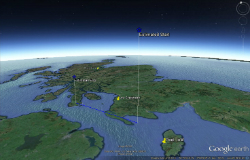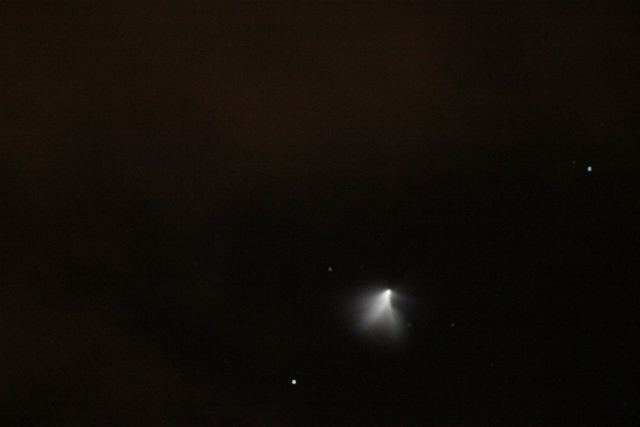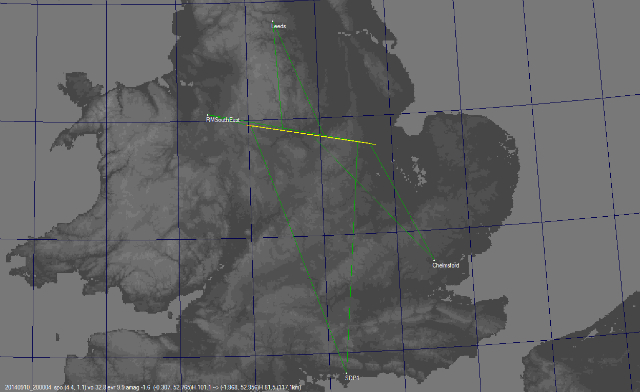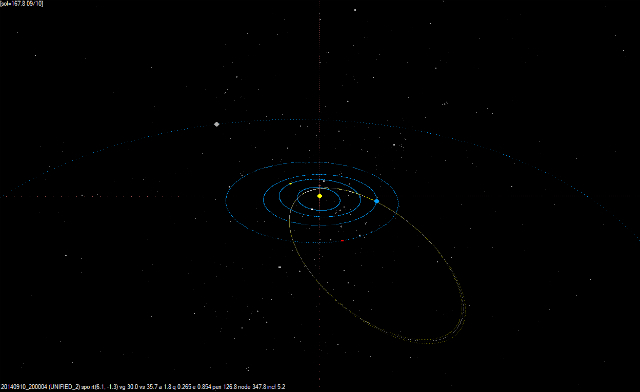Forum Replies Created
-
AuthorPosts
-
 William StewartParticipant
William StewartParticipantCRS-11 capsule and second stage booster easily seen from Cheshire 22 minutes after launch as two bright points of light flying in very close formation with two fainter points (jettisoned solar panel covers) either side.
Hope everyone else managed to see them too!
 William StewartParticipant
William StewartParticipantAs noted by Nick, last night’s launch was scrubbed (due to lightening in the area – one of the lessons learned from the Apollo 12 launch). There’s some time sensitive items in the payload that need to be swapped out and hence the next launch attempt will be Saturday 03rd June at 21:07 GMT. As before, the CRS-11 module and secondary booster should be visible from the British Isles approximately 20 minutes after launch. While the forecast for weather in this part of the world is better than what we had last night, the moon phase will have increased and hence is more likely to hinder observations. Updated plots (based on Marco Langbroek’s updated elset) attached – all times (see time-slider at the bottom of the plots) are GMT so you’ll need to add an hour to convert to BST.
For those who are interested, there’s some informed speculation from Ted Molczan as to what role USA-276 / NROL-76 may play in all this.
Best regards
William
 William StewartParticipant
William StewartParticipant… which is probably isn’t but if you fancy a look, latest chart attached. It will / would have entered earth’s shadow at 22.49 GMT tonight.
 William StewartParticipant
William StewartParticipantHi All,
The uncertainty in the time of decay has reduced from +/- 20 hours to +/- 12 hours and is now predicted for 15:00 UTC on 20th May over South America … which is not only a long way from the UK bit also during the hours of daylight.
Given the orbital period and inclination, it could still come down just about anywhere so let’s see what the next update brings.
Best regards
William
 William StewartParticipant
William StewartParticipantI neglected to mention typical performance of the original Watec 902H. I operate three of these as my main cameras from a resonably dark site (visual LM is about +5.5). Fitted with Computar 8mm f0.8 lenses, stellar LM on the cameras is +5.5 and the faintest meteors recorded are typically +3.2
 William StewartParticipant
William StewartParticipantHi All,
This document on the NEMETODE website provides recommendations for the various settings (and indeed where some of the difficult to find switches are) on the different versions of Watec 902 (and 910) cameras.
It should be noted that the original Watec 902H is unable to drive the iris on a DC Auto Iris lens (see page 5 of the document). Removing the plug and applying a voltage across the apporpriate wires fuly opens the iris.
For the original Watec 902H I’d recommend keeping the Shutter OFF and experiemnting with the (tiny) AGC switch. Depending on the camera itself (depending on when they were made, there appear to be some differences in design / manufacturing tolerances) and local light pollution levels, some report better images in the HI position while others report LO. The factory default is HI. When used with an Osprey 210 video card, the optimal position is usually LO.
As noted in earlier posts, it’s definitely worth optimising the brightness / contrast settings (usually software sliders).
Hope this helps.
William
 William StewartParticipant
William StewartParticipantMichael O’Connell picked this up on his all sky camera. he’s posted a video here.
 William StewartParticipant
William StewartParticipantRather unspectacular from Cheshire too, with the lower elevation and patchy mist not helping matters. Unable to pick it up in 12×80 binos until shadow exit. Visual appearance resembled any other faint satellite with no evidence of elongation / plume etc.
Cees, observing from The Netherlands, had better luck with his image suggesting evidence of venting.
 William StewartParticipant
William StewartParticipantAlas all NEMETODE cameras that could have had this in their field of view were clouded out … except for those operated by David Anderson in Low Craighead. Combining David’s data with the publically available still imagery has allowed the trajectory and magnitude to be estimated. The magnitude appears to have been of the order of -10. Further details on the NEMETODE website but safe to say it was a long way from Loch Ness!
William
 9 February 2015 at 8:21 am in reply to: Potential visibility of a fuel dump from a rocket booster #576791
9 February 2015 at 8:21 am in reply to: Potential visibility of a fuel dump from a rocket booster #576791 William StewartParticipant
William StewartParticipantMichael Guinan has been in touch to share a photograph of this fuel dump that he obtained from Waterford City, Ireland at 05:36 GMT on 2014 December 13th with a Canon 1Dx camera fitted with a 24 – 70mm lens. The exposure was 10s at at f/4 at ISO 6400. Below is the original and a crop.
Michael write, “I happened to be out photographing the stars on that morning and witnessed the fuel dump. It was an impressive sight. Although I am a beginner at astrophotography, I managed to capture some nice images of the fuel dump that I’d like to share (see attached). I hope you like them.“
With many thanks to Michael for sharing these (am posting them here on behalf of Michael, with his permission) … great to see a widefield shot like this that puts the observation in context.
William

.jpg)
 William StewartParticipant
William StewartParticipantHi Bill,
In short, yes, gve me a call and I’ll talk you through the process.
Cheers
William
 William StewartParticipant
William StewartParticipantHi Bill,
Looks like you’re getting some very interesting results – hopefully by now you have enough for a paper 🙂
Would be be very interested to see how the emission line intensities vary with ablation rate (which could be inferred from altitude / deceleration) … hopefully it won’t be too long before we can get triangulation data on one of your “spectral” meteors.
Clear skies
William
30 December 2014 at 6:23 pm in reply to: Potential visibility of a fuel dump from a rocket booster #576726 William StewartParticipant
William StewartParticipantHi All,
Just wanted to draw attention to the analysis by Cees Bassa that makes use of the DSLR imagery from Ravensmoor, plus other observations, to estimate the delta-v imparted to the Centaur booster as part of the CCAM and de-orbit burn. Cees’ analysis includes composite images and an animation and is available here.
Many thanks to Cees for his analysis.
Best regards
William
 William StewartParticipant
William StewartParticipantHi Bill,
Excellent – really pleased to see you obtaining this quality of data. Obviously the different spectra are of different widths … is this a reult of the use of different gratings for the different observations?
Best regards
William
13 December 2014 at 8:04 am in reply to: Potential visibility of a fuel dump from a rocket booster #576705 William StewartParticipant
William StewartParticipantHi Nick,
Sorry to hear you were clouded out 🙁
I’ve waited many years to see one of these – really glad that I’ve had a chance to witness it (even got the kids up to have a look). It’s a sight I’ll not forget.
Have seen the “fast moving comet” reports and your update 🙂
Reminds me of a few years ago when I saw the shuttle orbiter Endeavor and the jettisoned external tank (see https://www.flickr.com/photos/ws_astrophotography/3724460713/) a few minutes after launch … again, one of those events I waited years to see. Funny thing was, I saw it again on the very next shuttle launch!
13 December 2014 at 6:54 am in reply to: Potential visibility of a fuel dump from a rocket booster #576703 William StewartParticipant
William StewartParticipantThe faint smudge just above the end of the meteor trail is the fading plume from the fuel dump, as seen by the Ravensmoor north-east camera.
 13 December 2014 at 6:19 am in reply to: Potential visibility of a fuel dump from a rocket booster #576702
13 December 2014 at 6:19 am in reply to: Potential visibility of a fuel dump from a rocket booster #576702 William StewartParticipant
William StewartParticipantWe had reasonably clear skies in Cheshire so was worth making the effort to go out to see this event.
The launch was delayed 7 minutes but 05:00 GMT rolled by and I’d still seen nothing – decided to stay out a bit longer to enjoy the meteors when the fuel dump suddenly appeared.
The Centaur upper stage is powered by liquid hydrogen and liquid oxygen and it would make sense to dump the fuel at different times. The first image was taken at 05:09:48 GMT. Just the initial plume is visible:

The second at 05:11:14 GMT – the initial plume is fading but the bright dot to the right is the second plume just starting to emerge from the booster:

The third at 05:13:30 GMT – first plume contines to fade, second plume getting brighter

05:19:34 GMT – first plume lost in cloud, structure now visible in second plume

Through occasional gaps in the clouds, the second plume continued to be visible to the unaided until around 05:40 GMT, still expanding, estimate it was around 0.5 degrees in diameter.
Alas the camera focus wasn’t as crisp as I’d have liked it – equipment used was a Canon EOS Rebel T2i with a 75-300mm lens (fully zoomed out to 300mm), ISO 6400, 1 second exposure.
Hope others were able to see this.
Best regards
William
PS Faint smudge from this also visible on video meteor cameras!
12 December 2014 at 8:59 am in reply to: Potential visibility of a fuel dump from a rocket booster #576700 William StewartParticipant
William StewartParticipantApologies, slight error in the previous post:
” … previous similar launches have resulted in a fuel dump occurring 45 to 80 minutes after launch.”
should have read
“… previous similar launches have resulted in a fuel dump occurring 45 to 80 minutes after the payload is inserted into orbit.”
The upshot of this is that observing conditions improve for UK observers with the dump now expected to commence (and be at it brightest) soon after the object clears the horizon for UK observers.
Best regards
William
 William StewartParticipant
William StewartParticipantDear All,
Just a quick note to clarify my previous posting, part of which read, “More commonly known as “Sprites” these particular events were in actual fact “Blue Jets” and occurred close to the Isle of Man.”
Having exchanged emails with Dr Martin Fullekrug (University of Bath), the observed TLSs are actually known as “Column Sprites” and not “Blue Jets”. Blue Jets are a different phenomena and emanate directly from the cloud top (ie at a much lower altitude). Apologies for any confusion caused.
In addition, the two small bright luminous regions below the leftmost column sprite are known as “beads” and are considered to be an interrupted column.
Best regards
William
 William StewartParticipant
William StewartParticipantThis meteor was also caught by the one of the cameras a South Downs Planetarium (courtesy John Mason & Russ Slater) and this data has helped refine the ground track. Now have increased confidence too in the orbit.


The previously advised characteristics remain essentially unchanged. Thanks to everyone who contributed to this analysis.
Best regards
William
-
AuthorPosts
